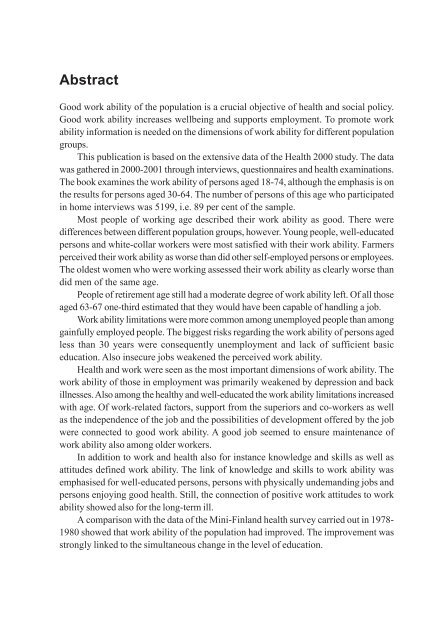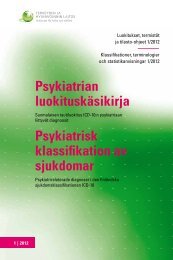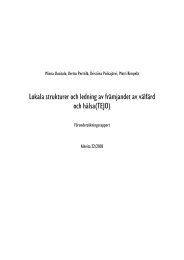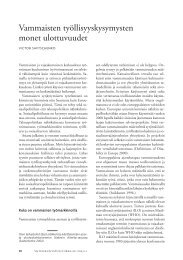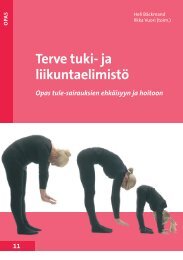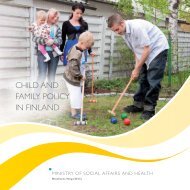- Page 1 and 2: Helsinki 2006 Työkyvyn ulottuvuude
- Page 3: Tiivistelmä Väestön hyvä työky
- Page 7 and 8: Esipuhe Työkyvyn ulottuvuudet -kir
- Page 9 and 10: Tuija Martelin, Päivi Sainio, Sepp
- Page 11: 7.5 Koulutus, taloudelliset tekijä
- Page 14 and 15: Työkyvyn ulottuvuudet aineisto ei
- Page 16 and 17: Työkyvyn ulottuvuudet 16
- Page 18 and 19: Työkyvyn ulottuvuudet nitaudeista
- Page 20 and 21: Työkyvyn ulottuvuudet ristön yhte
- Page 22 and 23: Työkyvyn ulottuvuudet 2.2 Työkyvy
- Page 24 and 25: Työkyvyn ulottuvuudet Yksilön voi
- Page 26 and 27: Työkyvyn ulottuvuudet Työkyvyn ed
- Page 28 and 29: Työkyvyn ulottuvuudet 2.3 Työkyky
- Page 30 and 31: Työkyvyn ulottuvuudet Samalla työ
- Page 32 and 33: Työkyvyn ulottuvuudet Työterveysh
- Page 34 and 35: Työkyvyn ulottuvuudet 2.5 Työkyky
- Page 36 and 37: Työkyvyn ulottuvuudet tä. Lisäks
- Page 38 and 39: Työkyvyn ulottuvuudet Aineiston ka
- Page 40 and 41: Työkyvyn ulottuvuudet eniten ja ka
- Page 42 and 43: Työkyvyn ulottuvuudet Työkykyinde
- Page 44 and 45: Työkyvyn ulottuvuudet Taulukko 3.2
- Page 46 and 47: Työkyvyn ulottuvuudet Kolmiportain
- Page 48 and 49: Työkyvyn ulottuvuudet tään kahde
- Page 50 and 51: Työkyvyn ulottuvuudet 3.3.4 Työky
- Page 52 and 53: Työkyvyn ulottuvuudet 3.3.5 Tärke
- Page 54 and 55:
Työkyvyn ulottuvuudet 3.4 Tilastol
- Page 56 and 57:
Työkyvyn ulottuvuudet siirtyvät y
- Page 58 and 59:
Työkyvyn ulottuvuudet Raija Gould,
- Page 60 and 61:
Työkyvyn ulottuvuudet Kuva 4.1.1.
- Page 62 and 63:
Työkyvyn ulottuvuudet Pohdinta Tul
- Page 64 and 65:
Työkyvyn ulottuvuudet Tuija Martel
- Page 66 and 67:
Työkyvyn ulottuvuudet Taulukko 4.2
- Page 68 and 69:
Työkyvyn ulottuvuudet tai ruotsink
- Page 70 and 71:
Työkyvyn ulottuvuudet listen väh
- Page 72 and 73:
Työkyvyn ulottuvuudet 72 3. 4. 5.
- Page 74 and 75:
Työkyvyn ulottuvuudet Pohdinta Aie
- Page 76 and 77:
Työkyvyn ulottuvuudet den väestö
- Page 78 and 79:
Työkyvyn ulottuvuudet Kuva 4.4.1.
- Page 80 and 81:
Työkyvyn ulottuvuudet samanlaiset
- Page 82 and 83:
Työkyvyn ulottuvuudet Raija Gould,
- Page 84 and 85:
Työkyvyn ulottuvuudet 84 9. tiöap
- Page 86 and 87:
Työkyvyn ulottuvuudet tuntijaryhm
- Page 88 and 89:
Työkyvyn ulottuvuudet kuin toimihe
- Page 90 and 91:
Työkyvyn ulottuvuudet Työn ulkopu
- Page 92 and 93:
Työkyvyn ulottuvuudet lutuksen ja
- Page 94 and 95:
Työkyvyn ulottuvuudet Työssä sel
- Page 96 and 97:
Työkyvyn ulottuvuudet samoin heill
- Page 98 and 99:
Työkyvyn ulottuvuudet Haastattelut
- Page 100 and 101:
Työkyvyn ulottuvuudet Taulukko 4.6
- Page 102 and 103:
Työkyvyn ulottuvuudet Yksinhuoltaj
- Page 104 and 105:
Työkyvyn ulottuvuudet Raija Gould,
- Page 106 and 107:
Työkyvyn ulottuvuudet Erillistarka
- Page 108 and 109:
Työkyvyn ulottuvuudet toimineilla
- Page 110 and 111:
Työkyvyn ulottuvuudet 110
- Page 112 and 113:
Työkyvyn ulottuvuudet tuen ja osal
- Page 114 and 115:
Työkyvyn ulottuvuudet Seppo Koskin
- Page 116 and 117:
Työkyvyn ulottuvuudet kuinka voima
- Page 118 and 119:
Työkyvyn ulottuvuudet Lähes joka
- Page 120 and 121:
Työkyvyn ulottuvuudet Taulukko 5.1
- Page 122 and 123:
Työkyvyn ulottuvuudet (taulukko 5.
- Page 124 and 125:
Työkyvyn ulottuvuudet Edellä main
- Page 126 and 127:
Työkyvyn ulottuvuudet Mielentervey
- Page 128 and 129:
Työkyvyn ulottuvuudet 5.1.7 Sairau
- Page 130 and 131:
Työkyvyn ulottuvuudet Työkyvyttö
- Page 132 and 133:
Työkyvyn ulottuvuudet Taulukko 5.1
- Page 134 and 135:
Työkyvyn ulottuvuudet väestön ty
- Page 136 and 137:
Työkyvyn ulottuvuudet nisaatiot. T
- Page 138 and 139:
Työkyvyn ulottuvuudet Taulukko 5.2
- Page 140 and 141:
Työkyvyn ulottuvuudet ja kuulovaik
- Page 142 and 143:
Työkyvyn ulottuvuudet Taulukko 5.2
- Page 144 and 145:
Työkyvyn ulottuvuudet tarvitaan yk
- Page 146 and 147:
Työkyvyn ulottuvuudet muutamalla p
- Page 148 and 149:
Työkyvyn ulottuvuudet 5.2.6 Toimin
- Page 150 and 151:
Työkyvyn ulottuvuudet na ryhminä
- Page 152 and 153:
Työkyvyn ulottuvuudet sen on todet
- Page 154 and 155:
Työkyvyn ulottuvuudet Vapaa-ajan l
- Page 156 and 157:
Työkyvyn ulottuvuudet Taulukko 5.3
- Page 158 and 159:
Työkyvyn ulottuvuudet Tupakoinnin
- Page 160 and 161:
Työkyvyn ulottuvuudet Taulukko 5.3
- Page 162 and 163:
Työkyvyn ulottuvuudet Raija Gould,
- Page 164 and 165:
Työkyvyn ulottuvuudet 5.4.1 Osaami
- Page 166 and 167:
Työkyvyn ulottuvuudet Osaamisvalmi
- Page 168 and 169:
Työkyvyn ulottuvuudet 5.4.3 Yhteen
- Page 170 and 171:
Työkyvyn ulottuvuudet tuminen työ
- Page 172 and 173:
Työkyvyn ulottuvuudet Taulukko 5.5
- Page 174 and 175:
Työkyvyn ulottuvuudet Taulukko 5.5
- Page 176 and 177:
Työkyvyn ulottuvuudet Kaija Tuomi,
- Page 178 and 179:
Työkyvyn ulottuvuudet viidennes ja
- Page 180 and 181:
Työkyvyn ulottuvuudet Taulukko 5.6
- Page 182 and 183:
Työkyvyn ulottuvuudet Taulukko 5.6
- Page 184 and 185:
Työkyvyn ulottuvuudet Kuva 5.6.3.
- Page 186 and 187:
Työkyvyn ulottuvuudet 5.6.6 Työn
- Page 188 and 189:
Työkyvyn ulottuvuudet 5.6.7 Yhteen
- Page 190 and 191:
Työkyvyn ulottuvuudet Tiina Pensol
- Page 192 and 193:
Työkyvyn ulottuvuudet 5.7.2 Sosiaa
- Page 194 and 195:
Työkyvyn ulottuvuudet Kuva 5.7.1 H
- Page 196 and 197:
Työkyvyn ulottuvuudet 196
- Page 198 and 199:
Työkyvyn ulottuvuudet Yhteiskunnan
- Page 200 and 201:
Työkyvyn ulottuvuudet Työkykyä s
- Page 202 and 203:
Työkyvyn ulottuvuudet Taulukko 6.2
- Page 204 and 205:
Työkyvyn ulottuvuudet Kuva 6.1. Ty
- Page 206 and 207:
Työkyvyn ulottuvuudet tujilla site
- Page 208 and 209:
Työkyvyn ulottuvuudet Taulukko 6.4
- Page 210 and 211:
Työkyvyn ulottuvuudet tietojensa j
- Page 212 and 213:
Työkyvyn ulottuvuudet Työtä kuva
- Page 214 and 215:
Työkyvyn ulottuvuudet pienemmät k
- Page 216 and 217:
Työkyvyn ulottuvuudet Kuva 6.6. Ty
- Page 218 and 219:
Työkyvyn ulottuvuudet työkyvyksi.
- Page 220 and 221:
Työkyvyn ulottuvuudet seen) kuvasi
- Page 222 and 223:
Työkyvyn ulottuvuudet tyivät sama
- Page 224 and 225:
Työkyvyn ulottuvuudet teen tai val
- Page 226 and 227:
Työkyvyn ulottuvuudet Menetelmät
- Page 228 and 229:
Työkyvyn ulottuvuudet Miesten ja n
- Page 230 and 231:
Työkyvyn ulottuvuudet arvioi työk
- Page 232 and 233:
Työkyvyn ulottuvuudet Taulukko 7.2
- Page 234 and 235:
Työkyvyn ulottuvuudet 7.5 Koulutus
- Page 236 and 237:
Työkyvyn ulottuvuudet työkyvyn ri
- Page 238 and 239:
Työkyvyn ulottuvuudet työttömyyt
- Page 240 and 241:
Työkyvyn ulottuvuudet 240
- Page 242 and 243:
Työkyvyn ulottuvuudet Nuorten työ
- Page 244 and 245:
Työkyvyn ulottuvuudet kijöitä ma
- Page 246 and 247:
Työkyvyn ulottuvuudet Taulukko 8.2
- Page 248 and 249:
Työkyvyn ulottuvuudet Taulukko 8.4
- Page 250 and 251:
Työkyvyn ulottuvuudet Taulukko 8.5
- Page 252 and 253:
Työkyvyn ulottuvuudet Taulukko 8.6
- Page 254 and 255:
Työkyvyn ulottuvuudet Tutkimuksen
- Page 256 and 257:
Työkyvyn ulottuvuudet ovat samansu
- Page 258 and 259:
Työkyvyn ulottuvuudet Luvussa 6 an
- Page 260 and 261:
Työkyvyn ulottuvuudet Työkyvyn os
- Page 262 and 263:
Työkyvyn ulottuvuudet aaliturvan r
- Page 264 and 265:
Työkyvyn ulottuvuudet Eri työmark
- Page 266 and 267:
Työkyvyn ulottuvuudet Taulukko 9.3
- Page 268 and 269:
Työkyvyn ulottuvuudet Kaikki edell
- Page 270 and 271:
Työkyvyn ulottuvuudet ovat siirtyn
- Page 272 and 273:
Työkyvyn ulottuvuudet 9.4 Työkyky
- Page 274 and 275:
Työkyvyn ulottuvuudet Taulukko 9.4
- Page 276 and 277:
Työkyvyn ulottuvuudet Aloitetaan t
- Page 278 and 279:
Työkyvyn ulottuvuudet dessä naist
- Page 280 and 281:
Työkyvyn ulottuvuudet Edellä esit
- Page 282 and 283:
Työkyvyn ulottuvuudet Kuva 9.5.1.
- Page 284 and 285:
Työkyvyn ulottuvuudet Taulukko 9.5
- Page 286 and 287:
Työkyvyn ulottuvuudet Taulukko 9.5
- Page 288 and 289:
Työkyvyn ulottuvuudet hön (Ilmari
- Page 290 and 291:
Työkyvyn ulottuvuudet Vanhuuseläk
- Page 292 and 293:
Työkyvyn ulottuvuudet suustyön os
- Page 294 and 295:
Työkyvyn ulottuvuudet 1980 kootun
- Page 296 and 297:
Työkyvyn ulottuvuudet Kuvassa 10.2
- Page 298 and 299:
Työkyvyn ulottuvuudet Miehillä ty
- Page 300 and 301:
Työkyvyn ulottuvuudet 10.4 Työkyv
- Page 302 and 303:
Työkyvyn ulottuvuudet 10.5 Työkyv
- Page 304 and 305:
Työkyvyn ulottuvuudet 10.6 Johtuuk
- Page 306 and 307:
Työkyvyn ulottuvuudet Taulukko 10.
- Page 308 and 309:
Työkyvyn ulottuvuudet Taulukko 10.
- Page 310 and 311:
Työkyvyn ulottuvuudet lyttävät j
- Page 312 and 313:
Työkyvyn ulottuvuudet arvioida kä
- Page 314 and 315:
Työkyvyn ulottuvuudet desta. Paino
- Page 316 and 317:
Työkyvyn ulottuvuudet vaikeudet as
- Page 318 and 319:
Työkyvyn ulottuvuudet syneisyys ja
- Page 320 and 321:
Työkyvyn ulottuvuudet Sosiaalinen
- Page 322 and 323:
Työkyvyn ulottuvuudet ovat parantu
- Page 324 and 325:
Työkyvyn ulottuvuudet Tarvitaan ty
- Page 326 and 327:
Työkyvyn ulottuvuudet Uusia tutkim
- Page 328 and 329:
Työkyvyn ulottuvuudet 328
- Page 330 and 331:
Työkyvyn ulottuvuudet Corporate Do
- Page 332 and 333:
Työkyvyn ulottuvuudet Huju P. 1976
- Page 334 and 335:
Työkyvyn ulottuvuudet Järvikoski
- Page 336 and 337:
Työkyvyn ulottuvuudet Laitinen J,
- Page 338 and 339:
Työkyvyn ulottuvuudet Piirainen H,
- Page 340 and 341:
Työkyvyn ulottuvuudet Suikkanen A.
- Page 342 and 343:
Työkyvyn ulottuvuudet Valkonen T,
- Page 344 and 345:
Työkyvyn ulottuvuudet Liitetauluko
- Page 346 and 347:
Työkyvyn ulottuvuudet Liitetaulukk
- Page 348 and 349:
Työkyvyn ulottuvuudet Liitetaulukk
- Page 350 and 351:
Työkyvyn ulottuvuudet Liitetaulukk
- Page 352 and 353:
Työkyvyn ulottuvuudet Liitetaulukk
- Page 354 and 355:
Työkyvyn ulottuvuudet Liitetaulukk
- Page 356 and 357:
Työkyvyn ulottuvuudet Liitetaulukk
- Page 358 and 359:
Työkyvyn ulottuvuudet Liitetaulukk
- Page 360 and 361:
Työkyvyn ulottuvuudet Liitetauluko
- Page 362 and 363:
Työkyvyn ulottuvuudet Liitetauluko
- Page 364 and 365:
Työkyvyn ulottuvuudet Liitetaulukk
- Page 366:
Työkyvyn ulottuvuudet 366


